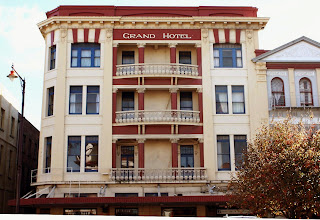No-ultima-thule-at-all. I'd say this is even the
anti-ultima-thule !
-----------------------------
Strange, unbelievable statistics from '
Blogger', show
I receive continued visits from such an impredictable, remote and continental place as
Ulaan Baatar (or
Ulan Bator), the capital of
Mongolia.
I don't get it! The
visit spot on the
blogger's visit map never turns off.
Several other remote and amazing locations come and disappear, make ephemeral visits - and make me so happy. But
Ulaan Baatar is on the visit map to stay, always present, without a break. Do I have many followers out there? But after all what is
there like ?
A nice 'Yurt' in central Ulaan Baatar.
Gandan, a budhist temple, the dominant religion. Some of them can be found in town, trapped between skyscrapers.
My amazement led me to do some research; and here I leave the results now.
*
Ulaan Baatar has a population of over one million people, which is amazing for what may well be the most interior capital of the world, far from the sea like no other. With an area of 1.5 million km2, Mongolia is a huge country, almost the size of India. However it has a population of less than three million, of which more than a third living in the capital - not the imperial capital of Genghis Khan, the ruined
Karakorum, but the modern capital
Ulaan Baatar.
The History of Mongolia was epic and grandiose. The fascinating Mongol Empire was as extensive as the Roman, and encompassed from the Baltic and the Danube to the Pacific, a large strip of territory diverse in civilizations and peoples. I can't even imagine how it was possible, during our Middle Ages, so thriving a civilization on Europe's doorstep. The
Pax Mongolica assured in the 13th century intense transcontinental trade routes across Eurasia. As expected, after the climax at the end of the century, the Empire finally collapsed and ended in 1368.
An animated vision of the Mongol expansion here:
http://en.wikipedia.org/wiki/File:Mongol_Empire_map.gif
That glorious past under the Khan dynasty faded to nothing but an almost deserted territory in the middle of nowhere, far from everything, underdeveloped and poor, stuck underneath Siberia, with a population of nomadic shepherds and a few villages in an isolation that only air flights and the
Trans-Siberian helped to endure.
Steppe, Gobi desert and mountains - an unforgiving territory.
After the country's independence, a sudden wealth source was found in intense exploitation of coal, gas and minerals: huge deposits of copper, lead, gold, tungsten, uranium, all known of the Soviet regime but carefully kept in secret!
Open-pit mine, one of many.
The profits mostly go to
Rio Tinto, some local business magnats, and what's left goes to favour the trade balance; Mongolia looks reborn in modernity.
Motorway into the capital. Like anywhere in Europe.
Sukhabatar square, the civic center. Under the central colonnade, a huge statue of Genghis Khan, the beloved national icon.
The historic icon.
A new icon.
If land doesn't allow farming or pasture, at least it delivers energy and high valued mineral rocks - a precious gift. As for pastures, they were mostly consumed by the goats, traditionally herded for the famous
Altai Cashmere, which despite the crisis remains famous and a relevant export, an exquisite and unique product.
'Altai Cashmere':
http://mcashmere.com/brands/altai-cashmere.html
This new Mongolia of fertile
subsoil, excavated and mostly deserted, leaves the nomadic life in the
yurts, and starts to build skyscrapers, airports, shopping malls, pedestrian streets with fountains and terraces.
Famous brand shops. Luxurious hotels. Even the sad prefabricated 5-floor blocks of the Soviet era are converted: with Greek columns at the door, here a pub, there a hairdresser, a mobile phone shop. Nothing of this is really new: just enthusiastic capitalism.
Peace Avenue, the largest in Mongolia, centralizes almost all trade and can be a traffic and pollution hell.
Hotel in Ulaan Baatar
Hotel in Karakorum, the old historic capital of the Empire.
Surreal.
Two worlds coexist, in sharp contrast, and Mongolia is one of the most unequal and polluted countries on the planet.
A 'Ger' (yurt campsite) in an outskirt neighbourhood. With car by the door.
Two cities.
Winter is still the worst, people may have to survive by -50° C. Yurts are heated by coal stoves, the cheapest, and smoke becomes unbearable - you can't even see the other side of the street.
*
A post-modern Yurt .
You will be always welcome, dear Mongol visitors, from your yurts or from your 15th floor lofts with a view.
----------------------
GDP growing 17.3% ! (2011)
GDP per capita $ 5 000
Fotos: Panoramio, Skyscrapercity


























































